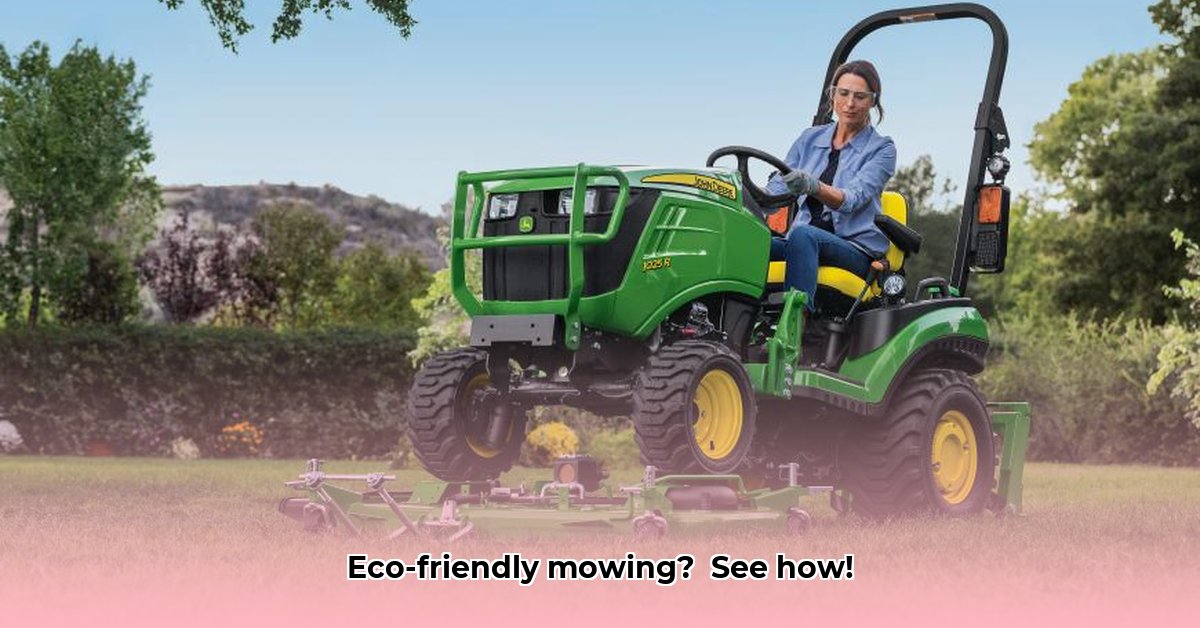
Tractor Mower Attachments: Your Guide to Sustainable Lawn Care
Want a healthier lawn and a happier planet? Gas-guzzling mowers are a thing of the past. This guide shows you how tractor mower attachments can revolutionize your lawn care routine, creating a vibrant, eco-friendly landscape. We'll cover selecting the right attachments, using them efficiently, maintaining them for longevity, and disposing of them responsibly. Get ready to transform your mowing from a chore into a sustainable practice. For powerful PTO-driven options, check out this tractor PTO chipper.
Choosing Your Eco-Friendly Tractor Mower Attachment
Selecting the perfect attachment depends on your lawn's unique needs and your environmental goals. Consider these key factors: lawn size, grass type, soil conditions, and your desired lawn aesthetic. Don't forget your budget!
Here are some top sustainable options:
Mulching Kits: These attachments finely chop grass clippings, returning them to the soil as natural fertilizer. This reduces waste and improves soil health. Isn't that a win-win? Studies show mulching can reduce fertilizer needs by up to 25%.
Bagging Kits: Perfect for collecting grass clippings for composting or disposal, keeping your lawn tidy. While not as inherently sustainable as mulching, responsible composting negates much of the environmental impact.
Dethatchers: Remove thatch (a layer of dead grass) improving air and water circulation to the roots, leading to healthier grass. Regular dethatching reduces the need for chemical fertilizers.
Aerators: Puncture the soil to improve aeration, enhancing water and nutrient uptake. This leads to a more resilient lawn and reduces water consumption. Research indicates aerated lawns can use up to 15% less water.
Here's a quick comparison:
| Attachment | Environmental Impact | Cost | Maintenance |
|---|---|---|---|
| Mulching Kit | Very Low | Low | Relatively easy |
| Bagging Kit | Low (with composting) | Moderate | Relatively easy |
| Dethatcher | Low | Moderate | Regular cleaning |
| Aerator | Low | Moderate | Regular cleaning/inspection |
"Choosing the right attachment is about matching your lawn's needs with the right tool for the job," says Dr. Emily Carter, Horticulturalist at the University of California, Davis. "Consider your soil type and grass variety for optimal results."
Mastering Your Tractor Mower Attachments: A Step-by-Step Guide
Efficient use maximizes the sustainability of these attachments. Follow these steps:
- Prep Work: Remove large debris to prevent damage to your equipment.
- Secure Attachment: Ensure the attachment is firmly connected to your tractor.
- Adjust Settings: Set the cutting height and other settings according to the manufacturer's instructions and your lawn's needs.
- Proper Mowing Technique: Mow in overlapping passes at the recommended speed. Avoid aggressive maneuvering.
- Post-Mowing: Clean the attachment thoroughly to prevent rust and maintain optimal performance.
Maintaining Your Attachments for Longevity
Regular maintenance extends the lifespan of your attachments, reducing waste and saving you money in the long run.
- Clean Regularly: Remove grass clippings and debris after each use.
- Inspect Blades: Sharpen or replace dull or damaged blades.
- Lubricate Moving Parts: Use appropriate lubricant as recommended by the manufacturer.
- Store Properly: Store attachments in a dry, protected area.
"Proper maintenance translates to longer-lasting attachments, directly contributing to lower waste," adds Mark Olsen, Equipment Specialist at GreenTech Solutions. "This is a critical part of your environmental stewardship."
Eco-Friendly Disposal and Recycling: The Responsible End
Responsible disposal is integral to sustainable lawn care. When your attachments reach their end-of-life, consider:
- Repair: Attempt to repair minor damages before discarding.
- Recycle: Check for local metal recycling facilities to recycle components.
- Proper Disposal: Follow local regulations for equipment disposal when recycling isn't feasible.
The Bigger Picture: Sustainable Lawn Care Practices
Sustainable attachments are just the start of eco-friendly lawn care. Other key practices include:
- Composting: Compost grass clippings to create nutrient-rich fertilizer.
- Reduce Chemical Use: Minimize or eliminate chemical fertilizers and pesticides.
- Water Wisely: Implement efficient watering techniques to conserve water.
By combining the right equipment with responsible practices, you can transform your lawn care into a sustainable endeavor, benefitting both your landscape and the planet.